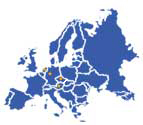
The
DECA project
The importance of religious architecture
as part of our European cultural heritage is undisputed, and this is endorsed
not least of all by the UNESCO World Heritage List. Particularly in the
case of religious buildings, however, cultural heritage should be seen
not just as architecture and a building's interior art work but also as
its accompanying archives which contain numerous records (plans, drawings,
sketches, photos, slides, ectachromes, glass panes and other documents).
These records play a key role in helping to preserve religious buildings.
They document the history of a building's construction and restoration
and are therefore the most important reference material for actual restoration
or maintenance work. In their entirety, archive records reflect the various
phases and eras of European architectural and art history.
Because of their age and the conditions under which
they are stored, many archived records visibly suffer from the decay process,
and in the foreseeable future, there is a risk they will no longer be
available to help restoration and construction work. The existence of
a key element of our sacral European cultural heritage is therefore in
danger.
The onset of this process of decay means, among other things, that even
now experts are rarely able to work with original copies of archive material.
And thus, access to this kind of cultural possessions is even more restricted
for the general public.
To preserve our European cultural heritage, it is crucial that existing
information, especially in archives (pictures, plans, texts etc.), be
transferred to other media and, by intelligently linking this data according
to thematic, spatial and logical aspects, a dense network of comprehensive
information be created which can be conveniently stored, researched and
retrieved.
Another aim of this project
is to develop user-oriented approaches and tried-and-tested ways of exploiting
new media to maintain and preserve our cultural heritage in European archives
and to suggest ways in which archives may be successfully supported by
new technologies to fulfil their specific tasks of preserving, documenting
and informing. A new system has to be created to support archives with
similar requirements in order to reduce the costs of their own developments.
Through the cooperation of European partners, willingness to use new media
in the cultural field will be promoted in the medium-term and a foundation
stone laid for a digital, European platform for religious architectural
and art history. Improved access to our cultural heritage will also promote
institutional cooperation on a European level and provide an impetus for a closer link between the cultural and technological sectors
Within
the framework of the "Culture 2000" programme, the European
Union granted an application for promotion of the project "DECA –
Digital European Cathedral Archives". The EU project will be carried
out between September 2002 and August 2003 in cooperation with Cologne
Cathedral, St. Stephan's Cathedral in Vienna, the University of Leiden
and Prague Castle. By digitalising the archive records of these institutions,
it aims to make archives digitally available, to store them under keywords
and to organise them in a database. Most importantly, this means improved
protection of archive records against decay since access to original documents
is largely avoided.
The project is devising a joint strategy and plan of action for this task
and some of the results will be published in a joint picture database
on the Internet.
Project
Management
Dombauverwaltung Köln
Roncalliplatz 2
50667 Cologne
0049-221-17940 300
info@dombauverwaltung-koeln.de
Cathedral architect Prof. Dr. Barbara Schock-Werner
Contact: Dr. Klaus Hardering
Project partners
Leiden (NL) – University of Leiden, Prof. Dr. Aart J.J. Mekking
Contact: drs. John Veerman
Prague (CZ) – Prague Castle, Mag. Martin Halata
Vienna (A) – Cathedral Construction Office St. Stephan, Cathedral
architect Arch. DI Wolfgang Zehetner
Contact: DI Peter Ebenhöh
Financial consultancy
Pax-Bank
Köln
Contact: Anja Schleef, M.A.
Digitalisation/Database technology
CD-LAB Nürnberg – Bonn
Contact: Dipl.-Ing. Ed Gartner & Dipl.-oec. Ulrich Gloede
![]() ___
___![]()